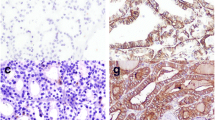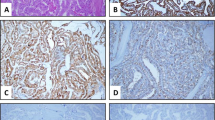Abstract
Differentiating the follicular derived lesions can be challenging. Although immunohistochemistry is generally accepted as a useful ancillary technique in the diagnosis, controversy exists regarding the best marker or combination of markers to distinguish each lesion from its mimics. In this study, we aimed at evaluating multiple markers to compare their sensitivity and usefulness, and to find out if a combination of the evaluated markers can be of additional value in discriminating thyroid lesions. The study included two groups of follicular derived thyroid lesions; benign group (Grave’s disease, nodular goiter, Hashimoto’s and adenoma) and malignant group (papillary, follicular carcinoma, well differentiated tumors of unknown malignant potential and follicular tumour of unknown malignant potential). Immunohistochemical evaluation of CD56, HBME-1, Gaectin-3 and CK19 were done. The sensitivity, specificity for each marker and their combination were calculated. Each marker was sensitive and specific for certain lesion but the sensitivity and specificity was increased when use combination of markers. Although no single marker is completely sensitive and specific for follicular thyroid lesions, the combination of CD56, HBME-1, Gaectin-3 and CK19 attains high sensitivity and specificity in diagnosis.




Similar content being viewed by others
References
Ying YL, Hans M, Job K et al (2008) Combined immunostaining with galectin-3, fibronectin-1, CITED-1, Hector Battifora mesothelial-1, cytokeratin-19, peroxisome proliferator-activated receptor-g, and sodium/iodide symporter antibodies for the differential diagnosis of non-medullary thyroid carcinoma. Eur J Endocrinol 158:375–384
Guido F, Esther DR, Marco R et al (2011) Follicular thyroid neoplasms can be classified as low- and high-risk according to HBME-1 and Galectin-3 expression on liquid-based fine-needle cytology. Eur J Endocrinol 165:447–453
Yoon LC, Mi KK, Jin-Won S et al (2005) Immunoexpression of HBME-1, high molecular weight cytokeratin, cytokeratin 19, thyroid transcription factor-1, and E-cadherin in thyroid carcinomas. J Korean Med Sci 20(5):853–859
Yasuhiro I, Hiroshi Y, Chisato T et al (2005) HBME-1 expression in follicular tumor of the thyroid: an investigation of whether it can be used as a marker to diagnose follicular carcinoma. Anticancer Res 25:179–182
Arturs O, Zenons N, Ilze S et al (2012) Immunohistochemical expression of HBME-1, E-cadherin, and CD56 in the differential diagnosis of thyroid nodules. Medicina (Kaunas) 48(10):507–514
Mauro P, Jaime R, Roberta DP et al (2005) Galectin-3 and HBME-1 expression in well-differentiated thyroid tumors with follicular architecture of uncertain malignant potential. Mod Pathol 18:541–546
Dina ED, Ahmed N, Salem A (2008) Application of CD56, P63 and CK19 immunohistochemistry in the diagnosis of papillary carcinoma of the thyroid. Diagn Pathol 3–5
Jeffrey L, Bhuvanesh S, Giovanni T et al (2006) Follicular variant of papillary thyroid carcinoma. A clinicopathologic study of a problematic entity. Cancer 107(6):1255–1264
Debdas B, Ram ND, Uttara C et al (2012) Cytokeratin 19 immunoreactivity in the diagnosis of papillary thyroid carcinoma. Indian J Med Paediatr Oncol 33(2):107–111
Rasha MA, Lobna SS (2012) Potential diagnostic utility of CD56 and claudin-1 in papillary thyroid carcinoma and solitary follicular thyroid nodules. J Egypt Natl Cancer Inst 24:175–184
Husain AS, Jining F, Farah T et al (2009) Differential expression of galectin-3, CK19, HBME1, and Ret oncoprotein in the diagnosis of thyroid neoplasms by fine needle aspiration biopsy. Cytojournal 6:18
Young JP, Soo HK, Dong CK et al (2007) Diagnostic value of galectin-3, HBME-1, cytokeratin 19, high molecular weight cytokeratin, cyclin D1 and p27kip1 in the differential diagnosis of thyroid nodules. J Korean Med Sci 22(4):621–628
Sandrine R, Brahim E, Sergio F et al (2002) Changes in galectin-7 and cytokeratin-19 expression during the progression of malignancy in thyroid tumors: diagnostic and biological implications. Mod Pathol 15(12):1294–1301
Prasad ML, Pellegata NS, Huang Y et al (2005) Galectin-3, fibronectin-1, CITED-1, HBME1 and cytokeratin-19 immunohistochemistry is useful for the differential diagnosis of thyroid tumors. Mod Pathol 18:48–57
de Matos PS, Ferreira AP, de Oliveira FF et al (2005) Usefulness of HBME-1, cytokeratin 19 and galectin-3 immunostaining in the diagnosis of thyroid malignancy. Histopathology 47:391–401
Ozolins A, Narbuts Z, Strumfa I et al (2010) Diagnostic utility of immunohistochemical panel in various thyroid pathologies. Langenbecks Arch Surg 395(7):885–891
DeLellis RA (2006) Pathology and genetics of thyroid carcinoma. J Surg Oncol 94(8):662–669
Chan JK (2002) Strict criteria should be applied in the diagnosis of encapsulated follicular variant of papillary thyroid carcinoma. Am J Clin Pathol 117:16–18
Williams ED (2000) Two proposals regarding the terminology of thyroid tumors. Int J Surg Pathol 8:181–183
Park WY, Jeong SM, Lee JH et al (2009) Diagnostic value of decreased expression of CD56 protein in papillary carcinoma of the thyroid gland. Basic Appl Pathol 2:63–68
Nasr MR, Mukhopadhyay S, Zhang S et al (2006) Immunohistochemical markers in diagnosis of papillary thyroid carcinoma: utility of HBME 1 combined with CK-19 immunostaining. Mod Pathol 19:1631–1637
Husain AS, Bo J, John B et al (2010) Utility of immunohistochemical markers in differentiating benign from malignant follicular-derived thyroid nodules. Diagn Pathol 5:9
Qingbin S, Deguang W, Yi L et al (2011) Diagnostic significance of CK19, TG, Ki67 and galectin-3 expression for papillary thyroid carcinoma in the northeastern region of China. Diagn Pathol 6:126–131
Shin MK, Kim JW, Ju Y (2011) CD56 and high molecular weight keratin as dignostic markers of papillary thyroid carcinoma. Korean J Pathol 45:477–484
Etem H, Ozekinci S, Mizrak B et al (2010) The role of CD56, HBME-1, and p63 in follicular neoplasms of the thyroid. J Pathol 26:238–242
Miettinen M, Karkkainen P (1996) Differential reactivity of HBME-1 and CD15 antibodies in benign and malignant thyroid tumours. Virchows Arch 429:213–219
Cheung CC, Ezzat S, Freeman JL et al (2001) Immunohistochemical diagnosis of papillary thyroid carcinoma. Mod Pathol 14:338–342
Gasbarri A, Martegani MP, Del Prete F et al (1999) Galectin-3 and CD44v6 isoforms in the preoperative evaluation of thyroid nodules. J Clin Oncol 17:3494–3499
Saggiorato E, De Pompa R, Volante M et al (2005) Characterization of thyroid ‘follicular neoplasms’ in fine-needle aspiration cytological specimens using a panel of immunohistochemical markers: a proposal for clinical application. Endocrinol Relat Cancer 12:305–317
Orlandi F, Saggiorato E, Pivano G et al (1998) Galectin-3 is a presurgical marker of human thyroid carcinoma. Cancer Res 58:3015–3020
Kovacs RB, Foldes J, Winkler G et al (2003) The investigation of galectin-3 in diseases of the thyroid gland. Eur J Endocrinol 149(5):449–453
Bartolazzi A, Gasbarri A, Papotti M et al (2001) Application of an immunodiagnostic method for improving preoperative diagnosis of nodular thyroid lesions. Lancet 357:1644–1650
Collet JF, Fajac A (2006) Galectin-3 immunodetection in thyroid fine-needle aspirates: technical procedure and results. Ann Pathol 26:347–351
Kim MJ, Kim HJ, Hong SJ et al (2006) Diagnostic utility of galectin-3 in aspirates of thyroid follicular lesions. Acta Cytol 50:28–34
Sahoo S, Hoda SA, Rosai J et al (2001) Cytokeratin 19 immunoreactivity in the diagnosis of papillary thyroid carcinoma. Am J Clin Pathol 116:696–702
Guyetant S, Michalak S, Valo I et al (2003) Diagnosis of the follicular variant of papillary thyroid carcinoma significance of immunohistochemistry. Ann Pathol 23:11–20
Conflict of Interest
The author declares that she has no conflict of interest.
Author information
Authors and Affiliations
Corresponding author
Rights and permissions
About this article
Cite this article
Alshenawy, H.A. Utility of Immunohistochemical Markers in Diagnosis of Follicular Cell Derived Thyroid Lesions. Pathol. Oncol. Res. 20, 819–828 (2014). https://doi.org/10.1007/s12253-014-9760-3
Received:
Accepted:
Published:
Issue Date:
DOI: https://doi.org/10.1007/s12253-014-9760-3




